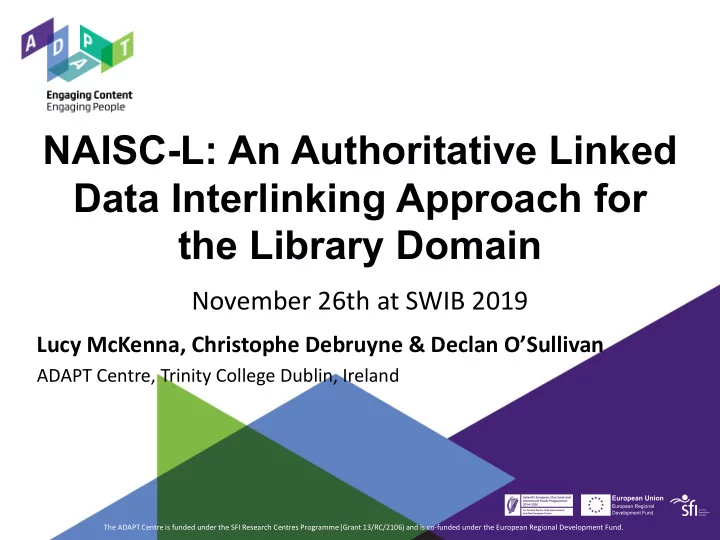

NAISC-L: An Authoritative Linked Data Interlinking Approach for the Library Domain November 26th at SWIB 2019 Lucy McKenna, Christophe Debruyne & Declan O’Sullivan ADAPT Centre, Trinity College Dublin, Ireland The ADAPT Centre is funded under the SFI Research Centres Programme (Grant 13/RC/2106) and is co-funded under the European Regional Development Fund.
Presentation Plan www.adaptcentre.ie • What is Linked Data interlinking? • Quick recap of SWIB 2018 presentation • NAISC-L framework • Discuss progress with NAISC-L • Usability Testing • Updates to GUI • Implementation of NAISC-L Provenance Model • Next steps 2
What is Linked Data Interlinking? www.adaptcentre.ie • Interlinking: Linking related entities across datasets. • Different degrees of relatedness e.g. owl:sameAs, skos:closeMatch, schema:isSimilarTo, dcterms:relation, rdfs:seeAlso • 5 Star Linked Data • Data enrichment • Knowledge discovery 3
What is NAISC-L? www.adaptcentre.ie • N ovel A uthoritative I nterlinking for S emantic Web C ataloguing in L ibraries. • Approach encompasses a LD interlinking framework and a provenance model • Developed a process and a graphical user-interface (GUI) to allow users to interact with the approach. • Reduce the need for expert technical/LD knowledge. • Focused on the specific requirements of IPs e.g. access to authorities, use of library vocabularies, link to other library datasets, provision of provenance data. 4
Interlinking Framework www.adaptcentre.ie 5
NAISC-L GUI - First Iteration - 2018 www.adaptcentre.ie 6
Usability Testing - 2019 www.adaptcentre.ie • Conducted usability testing in January 2019 • Evaluated the framework process, RDF output, usability of the GUI and a provenance data demo • Participants – 15 Information Professionals • Academic libraries, national library, archive • Four parts: 1. Pre-Test Questionnaire 2. Think-Aloud Observation 3. Post-Test Interview 4. PSSUQ Questionnaire 7
Results www.adaptcentre.ie Pre-Test Questionnaire Semantic Linked RDF URIs Ontologies Knowledge Ratings Web Data Not at all Knowledgeable 0 0 0 0 0 Slightly Knowledgeable 2 1 5 4 5 Moderately Knowledgeable 13 14 10 9 8 Very Knowledgeable 0 0 0 2 2 Extremely Knowledgeable 0 0 0 0 0 • Five of the participants indicated that they had previous experience implementing a LD project 8
Results www.adaptcentre.ie Think-Aloud Test Task Challenges 1. Create New Clearer descriptions of the information required in each field Project/Linkset in the form 2. Add Internal Entity Unclear on which button to click in order to add an entity 3. Add External Entity Links to external authorities were not always noticed by participants as they were at the bottom of the page. 4. Create 6 Interlinks Some participants initially found it difficult to identify which two entities they were interlinking – suggested colour coding. 5. Generate Interlink RDF Participants suggested adding natural language labels to make the graphs more readable 6. Review Provence Graph Suggested having different levels for viewing the visualisation demo • Participants were 100% successful in following the framework process. 9
Results www.adaptcentre.ie Interviews • Overall Impression: NAISC-L was easy and pleasant to use and that, as they became used to the system, the ease and speed of use increased. • Positives: RDF graphs of the interlink data added to their understanding of the interlinking process. • Link-Type Selection: The participants indicated that the definitions for each of the link-types were useful for deciding on how to express the relation between two URIs. • Usefulness: All participants stated that NAISC-L would be useful for creating interlinks between internal and external LD resources. PSSUQ System Information Interface Overall Usefulness Quality Quality Average Score 2.45 2.45 2.65 2.07 Mild Mild Mild Mild 10
NAISC-L GUI - Second Iteration 2019 www.adaptcentre.ie 11
NAISC-L GUI - Second Iteration 2019 www.adaptcentre.ie 12
NAISC-L GUI – Interlink Output www.adaptcentre.ie NAISC GUI – Graphical RDF Output 13 Generated using GoJS software
Provenance Model www.adaptcentre.ie 14
NAISC-L GUI – Provenance Output www.adaptcentre.ie NAISC GUI – Graphical RDF Output 15 Generated using GoJS software
NAISC-L GUI – Relationship Graph www.adaptcentre.ie • Links the interlink named graph with the provenance named graph. { <http://naisc.adaptcentre.ie/linkset/53> prov:has_provenance <http://naisc.adaptcentre.ie/linkset/53/provenance/32> . } 16
Future Directions www.adaptcentre.ie In the process of evaluating the second iteration of NAISC-L (100+ participants) In the process of conducting a field test of NAISC-L in the Irish Traditional Music Archive (6 Information Professionals) Provide feedback on results 17
Finally! www.adaptcentre.ie I need your feedback! Participate in an evaluation of NAISC-L! https://scsstcd.qualtrics.com/jfe/form/SV_cJ9VBQ2BuNbvbc F 18
Thank you! www.adaptcentre.ie • Lucy McKenna • PhD student, ADAPT Centre, Trinity College Dublin • Email: lucy.mckenna@adaptcentre.ie • NAISC-L interface demo: https://www.scss.tcd.ie/~mckennl3/naisc • NAISC-L Questionnaire: https://scsstcd.qualtrics.com/jfe/form/SV_cJ9VBQ2BuNbvb cF 19
References www.adaptcentre.ie • Ali, I., & Warraich, N. F. (2018). Linked data initiatives in libraries and information centres: a systematic review. 36(5), 925-937. doi:10.1108/EL-04-2018-0075 • Deliot, C., Wilson, N., Costabello, L., & Vandenbussche, P. Y. (2016). The British National Bibliography: Who uses our Linked Data? • Hastings, R. (2015). Linked Data in Libraries: Status and Future Direction. Computers in Libraries, 35(9), 12-16. • L. Moreau, P. Groth, J. Cheney, T. Lebo, and S. Miles. 2015. The rationale of PROV. • Web Semantics: Science, Services and Agents on the World Wide Web 35 (2015), • 235–257. • McKenna, L., Debruyne, C., & O'Sullivan, D. (2018, May). Understanding the Position of Information Professionals with regards to Linked Data: A Survey of Libraries, Archives and Museums. In Proceedings of the 18th ACM/IEEE on Joint Conference on Digital Libraries (pp. 7- 16). ACM. • Vander Sande, M., Verborgh, R., Hochstenbach, P., & Van de Sompel, H. (2018). Toward sustainable publishing and querying of distributed Linked Data archives. Journal of Documentation, 74(1), 195-222. • doi:doi:10.1108/JD-03-2017-0040 • Wang, Y., & Yang, S. Q. (2018). Linked Data Technologies and What Libraries Have Accomplished So Far. International Journal of Librarianship, 3(1). doi:10.23974/ijol.2018.vol3.1.62 • W3C (2013). PROVO-O: The PROV Ontology. Retrieved 19/11/18 from https://www.w3.org/TR/prov-o/ 20
Recommend
More recommend